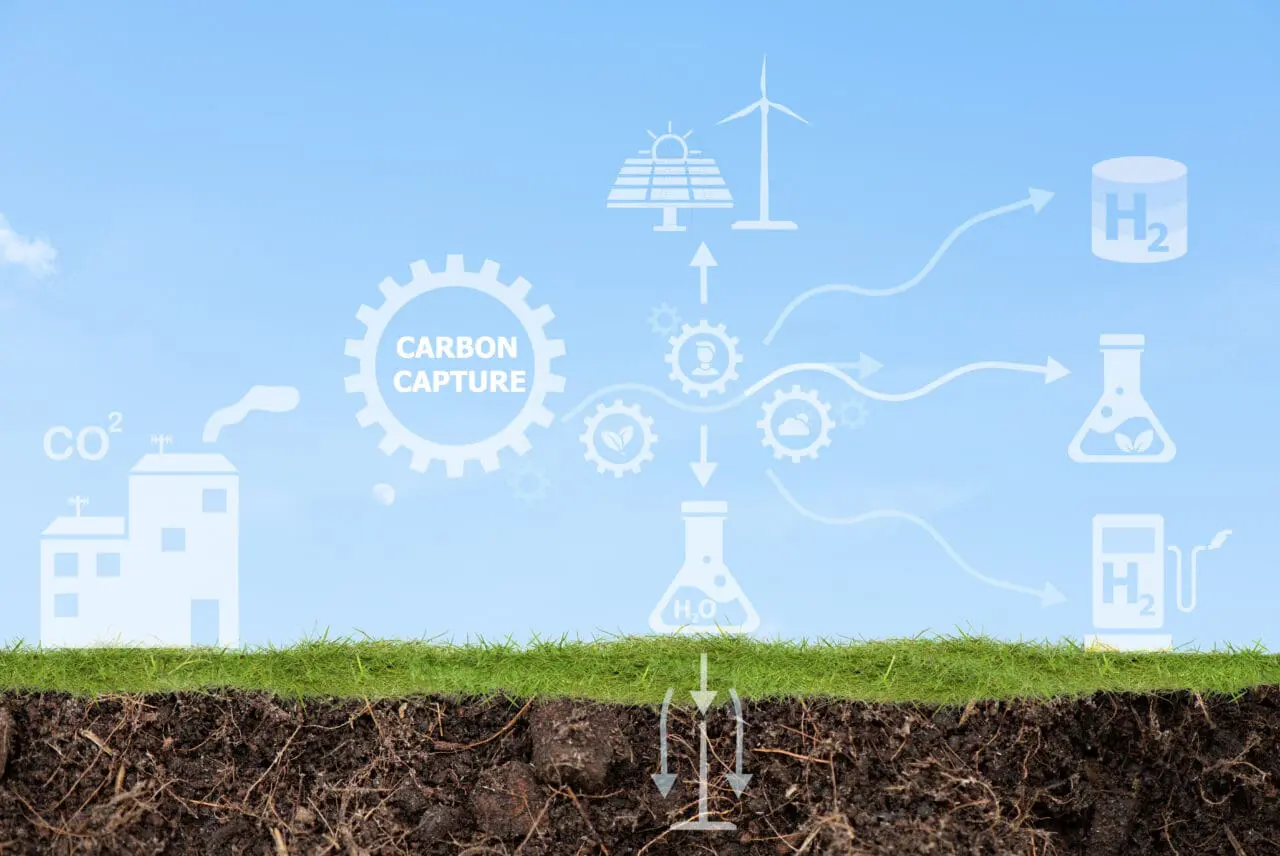

Introducing Mammoth, the world’s largest Direct Air Capture (DAC) plant, now fully operational in Iceland, marking a significant leap forward in our fight against global warming. With an astounding capacity for carbon dioxide removal amounting to 36,000 tons per year—equivalent to taking 7,800 petrol-fuelled cars off the road—Mammoth exemplifies cutting-edge environmental technology. Developed by Climeworks, this state-of-the-art facility captures CO₂ directly from the atmosphere and securely stores it deep underground, preventing its re-release for over 10,000 years and ensuring a long-term impact on atmospheric carbon levels. Powered by a geothermal plant, Mammoth operates on renewable energy sources, avoiding the pitfalls of natural gas and other non-renewable energy consumption that could otherwise undermine its environmental benefits. While DAC technology like Mammoth faces challenges around cost-efficiency and scalability, its potential role in global climate strategies is undeniable. This initiative underscores the urgent need for industries worldwide to rethink their environmental footprints, adopting such innovative solutions as a vital part of a comprehensive approach to reducing emissions and combating climate change.
Stepping inside Mammoth reveals a meticulously designed infrastructure dedicated to unprecedented carbon removal from the atmosphere. This direct air capture facility operates through a series of advanced air filtration units that capture CO₂, which is then subjected to a process of condensation and storage. Each unit is engineered to perform optimally even under harsh climatic conditions, leveraging Iceland’s geothermal power to maintain energy efficiency. The extracted carbon dioxide is transported deep underground into basalt rock formations, where it mineralises over time, ensuring long-term carbon capture and storage. The vast scale of operations at Mammoth is impressive, with the ambition to scale up capabilities to multi-megaton by the 2030s and reach gigaton levels by 2050. This facility not only illustrates practical applications of cutting-edge direct air capture technology but also sets a powerful precedent for future developments in the realm of negative emissions and climate solutions.
Climeworks envisions a future where Direct Air Carbon Capture (DAC) technology scales to a multi-megaton capacity by the 2030s and achieves gigaton capacity by 2050. This ambitious goal is rooted in their commitment to tackling global warming head-on through innovative and scalable solutions in carbon engineering. By leveraging their groundbreaking facility, Mammoth, as a blueprint, Climeworks aims to expand its operations extensively. This expansion is not just about increasing capacity; it’s about refining the technology to be more cost-effective and efficient, ensuring it remains a crucial element in the global fight against climate change. As part of their forward-thinking strategy, Climeworks plans to integrate advancements in air filtration, ambient air capture, energy efficiency, and carbon sequestration techniques, as well as utilising waste heat and enhanced oil recovery methods to further underpin their dedication to environmental sustainability. This vast upscaling effort signifies a beacon of hope, showcasing the potential for human ingenuity to address one of the most pressing challenges of our time.
The Mammoth DAC plant’s reliance on renewable electricity from geothermal power is a key factor that amplifies its positive environmental impact. This use of geothermal energy, a renewable source derived from the Earth’s internal heat, ensures that operations at Mammoth are both sustainable and efficient. By harnessing this clean energy, Mammoth sidesteps the environmental drawbacks associated with fossil fuel-based power sources. This strategic choice not only enhances the plant’s overall carbon removal capacity but also aligns with broader goals of reducing greenhouse gas emissions and achieving deep emissions reductions. The utilisation of renewable electricity in operating Mammoth signifies a significant stride in ensuring that cutting-edge direct air capture technologies and negative emissions technologies do not inadvertently contribute to the problem they aim to solve. Through this innovative integration, Mammoth sets a pioneering example of how renewable energy can bolster the effectiveness of advanced environmental technologies.
Despite the groundbreaking success of Mammoth and similar direct air capture technologies, these innovations have sparked controversy. Critics often cite the high costs associated with the direct air capture process and question its scalability to significantly impact global carbon dioxide levels. However, proponents argue that as the technology evolves, economies of scale will reduce costs and enhance efficiency. The reliance on renewable energy like geothermal power also counters arguments about the potential indirect environmental impacts of operating such facilities. Another point of contention is the perceived competition between direct air capture technology and other carbon removal technologies, yet experts emphasize that a multifaceted approach, combining the direct air capture process with energy efficiency and emission reductions, is essential for addressing the climate crisis. Mammoth exemplifies how cutting-edge implementation and strategic planning can overcome these controversies, paving the way for widespread acceptance and deployment of direct air capture technology.
The Mammoth DAC facility’s significant impact on carbon dioxide removal equates to the elimination of thousands of petrol-powered cars from the road. By capturing and permanently sequestering CO₂, Mammoth contributes to carbon removals on a large scale, offsetting emissions typically produced by a vast number of vehicles and thereby helping to meet climate targets. This energy-intensive technology, powered by renewable geothermal energy instead of natural gas, ensures that environmental benefits are not compromised by reliance on fossil fuels. As Mammoth scales its operations, its contribution to cleaner air and reduced greenhouse gases presents a compelling alternative to traditional methods of pollution control. By replacing the carbon footprint of thousands of cars with sustainable carbon capture, Mammoth underscores the potential of DAC technology to dramatically shift our approach to mitigating climate change and progressing toward a pollution-free future.
Businesses worldwide have a pivotal role to play in achieving net zero emissions, and incorporating Direct Air Capture (DAC) technology into their environmental strategies can make a substantial difference. By leveraging advanced solutions like Climeworks’ Mammoth facility, which captures carbon from ambient air, companies can actively participate in carbon capture and storage, effectively reducing their carbon footprint. Integrating DAC with technologies like pure gas and industrial cooling towers not only showcases a commitment to sustainability but also aligns with emerging regulations and consumer expectations for greener practices. It’s crucial for businesses to invest in such cutting-edge technologies, including carbon engineering, as they provide scalable and efficient means of addressing carbon emissions, promising a more sustainable future. As the technology evolves and becomes more cost-effective, early adoption will position businesses not just as corporate citizens but as leaders in the global effort to tackle climate change. The time to act is now; by integrating DAC and other carbon capture technologies into corporate environmental strategies, businesses can play a transformative role in ensuring a cleaner, healthier planet.
While Direct Air Capture (DAC) technologies like the Mammoth facility play a pivotal role in carbon removal, addressing climate change demands a multifaceted approach that includes reducing emissions at the source. Enhanced oil recovery can benefit from carbon capture, but large-scale deployment of DAC requires complementary strategies. Preventive measures such as enhancing energy efficiency, transitioning to renewable energy sources, and implementing stricter emissions regulations are essential. By curbing emissions at their origin, we can significantly decrease the volume of CO₂ and other greenhouse gases released into the atmosphere. This proactive strategy not only supports DAC efforts but also ensures a more sustainable reduction of our carbon footprint. Integrating emission reduction initiatives with advanced carbon capture solutions creates a resilient framework capable of tackling climate change from multiple angles, paving the way for a healthier planet for future generations.
Immediate action to combat global warming is no longer a choice but a necessity. Innovative technologies like the Mammoth DAC facility and direct air carbon capture exemplify our potential to make significant strides in carbon dioxide reduction. Carbon engineering through direct air capture is a pivotal tool in achieving our global climate goals. However, relying solely on such technologies is insufficient. To comprehensively address the climate crisis, we must adopt a holistic approach that includes reducing emissions at their source, enhancing energy efficiency, and transitioning to renewable energy. Early adoption of advanced solutions and the integration of multifaceted strategies are crucial. Failing to act decisively now risks exacerbating climate-related catastrophes and undermines the progress we’ve made. The cost of inaction is far too high, affecting not only the environment but also economic stability and public health. By embracing cutting-edge technologies and committing to sustainable practices today, we can safeguard our planet for future generations and ensure a liveable world for all.

This website uses cookies to improve your experience. Choose what you're happy with.
Required for the site to function and can't be switched off.
Help us improve the website. Turn on if you agree.
Used for ads and personalisation. Turn on if you agree.
This website uses cookies to improve your experience. Choose what you're happy with.
Required for the site to function and can't be switched off.
Help us improve the website. Turn on if you agree.
Used for ads and personalisation. Turn on if you agree.